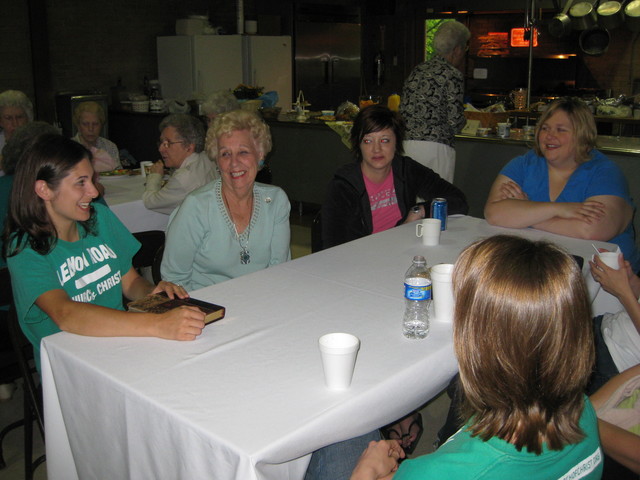Guest Post: The Church and Technology
[Today’s post is the 2nd in our series entitled “The Church and…”. The writer today is my friend Dale Jenkins. Dale preaches for the Spring Meadows church of Christ in Spring Hill, Tennessee. He wears many hats, including cohosting iPreach the podcast with me. It is a joy to work with Dale in this way. Make sure you check out his “Blog that Binds” here.]
“And whatever you do, in word or deed, do everything in the name of the Lord Jesus, giving thanks to God the Father through him” (Colossians 3:17).
Somewhere between 1436 and 1450 Gutenburg is credited as having invented the printing press (wonder how many people thought, “I should have thought about that”). The first uses of it were religious in nature. The first book printed was the Bible and the first book printed in color was the book of Psalms. Charlie Carter was the first man between Montgomery and Dothan Alabama to have electricity. After he had it run to his house, he ran a wire from his house to the church building and it is believed that the second building in that 100 plus mile stretch to have power was the church building. One of the first public buildings to have air conditioning in Nashville was the Granny White Church of Christ. The first radio station in America was KDKA in Pennsylvania, going on the air in November 1920. Less than three months later Calvary Episcopal church began the first live religious broadcast (It’s a little known fact that he also said: “Send your love offering in and be sure to include the call letters of the station you hear this broadcast on”). The broadcast was of their services and was broadcast over what was then called a “wireless telephone receiving apparatus.” (1) According to the Barna Institute’s 2008 study 9 out of 10 churches of 250 members use large screen projections, 75% of churches of 100 members or more have a web-presence. (2) Churches have long led the way in technology.
In fact, some of us believe that the reason God has allowed technology to be developed is primarily so that the church can take it captive for His cause and use in every good way! (2Co 10:5); so that the glory may go to God in all things (Col 1:18).
 But the speed with which technology has increased is amazing. Turn around twice and you’ll miss it all (turn around three times and you’ll get dizzy and fall, trust me I know). It took radio 38 years to reach 50 million listeners. TV took 13 years to reach 50 million users. The Internet took four years to reach 50 million people (iPreach is still on it’s way to getting it’s 50 millionth listener). (3)
But the speed with which technology has increased is amazing. Turn around twice and you’ll miss it all (turn around three times and you’ll get dizzy and fall, trust me I know). It took radio 38 years to reach 50 million listeners. TV took 13 years to reach 50 million users. The Internet took four years to reach 50 million people (iPreach is still on it’s way to getting it’s 50 millionth listener). (3)
Or think about “social networking.” As best I can research, the term really didn’t even exist until about 2005. But consider: In less than nine months, Facebook added 100 million users. More than 120 million users log on to Facebook at least once each day and more than 30 million users update their statuses at least once each day. Combined, more than 5 billion minutes are spent on the site on a daily basis. The site has more than 250 million active users. Over one billion photos are uploaded every month. And 30 million users update their page via their mobile phone. If Facebook were a country, it would be the fourth most populated place in the world (it would also need a landmass, but that’s another story). This means it easily beats the likes of Brazil, Russia and Japan in terms of size.
Then there’s Twitter: Over the past 12 months, Twitter’s year-on-year growth rate has broken the 1000% barrier. The chief Twits don’t like to share numbers, but it is estimated that Twitter currently has between 6-10 million users. And there is no doubt that it is growing rapidly. And, “Twitter” is now officially a term in the English Dictionary.
The internet has “virtually” replaced the library, bringing it “home”. Wikipedia has more than 13 million articles and boasts over 60 million unique users a month.
75 billion videos are likely to be seen this year via YouTube. And it will serve around 375 million unique visitors during this year.
And if you’d told me I would be writing a guest blog 9 years ago I would have thought of the ’70’s horror flick (The Blob). According to Technorati there are more than 133 million active blogs and 900,000 new blog posts are created every 24 hours. Universal McCann reports that 77% of all active internet users regularly read blogs. (4)
Anyone who thinks technology is nothing more than a passing fad or that the church is “wasting it’s time playing with toys” better get their head out of the sand. So how can the church that preaches the ancient truth get the most out of modern tech tools? Here’s a few tips:
- As technology changes remember the things that don’t. All the changes can sometimes leave our heads spinning and leave us wondering if we will ever catch up, ever utilize it all or ever get a grip, so focus on what does not change: The Word of God, the Love of God, the Purpose that God has for us.
- Manage technology. If you buy everything out there you will go broke and tomorrow someone will tell you of two more things you need and one of the things you bought yesterday that is already outdated. It’s a vicious cycle, so decide what you want to do. Just because someone tells you that you need the latest and greatest doesn’t mean you do. Make sure what it does is something you want and need.
- Don’t underbuy: Don’t stay 10 years behind. You’ll make the church appear irrelevant. Obviously there is a delicate balance between numbers 2 and 3 there. Here’s a suggestion. Budget in a part of your budget each year and you should be able to pretty much stay as current as you need to. I’m not sure, but a good measuring stick would probably be 3-5%.
- Use committees: Avoid the “tech guy” syndrome. While most churches may have a “go to guy” few people know all the sources and resources needed for a total tech picture. Having a committee not only involves more people it also will give you different vantage points on how to accomplish what you want to accomplish. Use the energies of all you can and you will get the most out of your systems and tech goals.
- Explain why! When the church goes viral with Twitter, FB, streams it’s services, launches into PowerPoint, etc. there will be those who do not see the value and wonder why churches would spend time and energy on “that junk”. Take time to explain how you intend to use it for outreach or edification. If done well most people will understand and appreciate it. But remember, that requires that you think the “why’s” through first!
- Be careful about building too much around technology. Frankly church is not about the new and shiny but about an old rugged cross. If you build your ministry on technology it will fail you. And if you are using it and it does not work, please don’t spend 20 minutes trying to get it going again. MOVE ON.
- Use technology to draw you closer. Some churches have lost the personal touch. Some tech tools can help foster community but most tend to isolate us to a screen and keyboard. Make sure you are still connecting with people and people to people!
- Sometimes the sound becomes too much. Turn off. Allow people the opportunity sometimes to totally disconnect – do take a technology “fast”. Sometimes don’t swamp them with your latest gadget or little thing you learned that you can do with technology. Sometimes people need a retreat FROM the new to the old.
——————-
REFERENCES:
(1) Armstrong, Ben, The Electric Church, Thomas Nelson 1979
(3) http://cyberschoolbus.un.org/briefing/technology/tech.pdf
(4) http://econsultancy.com/blog/4327-20-+-mind-blowing-social-media-statistics



5 Comments
Scott
Great stuff. I love the bullets at the end. Now I will pass this along to the “tech guy.”
Pingback:
Randal
Good advice, all around. New media for the eternal word. Making it work is the challenge.
Pingback:
Pingback: